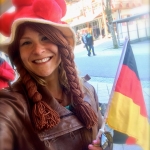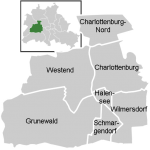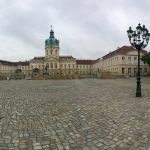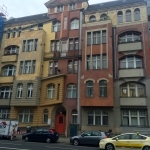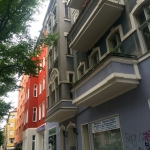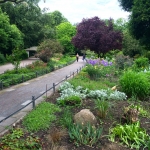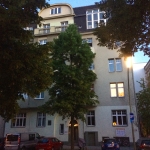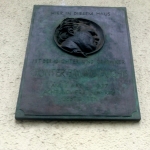Keiz: Wilmersdorf, Berlin, Germany
Location: Former West
Population: 94,113
Charlottenburg-Wilmersdorf
In 2001 Berlin underwent some reconstruction; there had been over 25 “Keiz,” but under new law many were combined. This is when Wilmersdorf was merged with Charlottenburg to create Charlottenburg-Wilmersdorf; most of the excitement of the area happens in Charlottenburg, here you can find sights such as the Charlottenburg Palace, Museum Berggruen, and Kaiser-Wilhelm-Gedächtinis Kirche.
Wilmersdorf
I, however, spent most of my time in the area around my house which was Wilmersdorf. Wilmersdorf covers a small area and can be reached by the U-Bahn tracks 9, 3, and 7, or one can take the S-Bahn ring. Some stereotypical views on Wilmersdorf are as follows: wealthier people, quieter place, nicer buildings to live in, and more of a jewish area.
Sights
Some notable sights in Wilmersdorf include the Berliner Moschee, Buddy Bear, and Volkspark. The Berliner Moschee is the oldest Mosque in Germany; it was built in 1923, damaged during the second World War, and then rebuild in 1999.
Buddy Bear is among the many Berlin Bären scattered across Berlin, and this bear is the most popular one to see in Wilmersdorf.
Lastly, my favorite place, Volkspark. This park is where I would go for a run and play basketball or enjoy the beautiful gardens, scenery, and Berliners. Although this park is beautiful with its very impressive flower gardens, it’s history has not been so peaceful. In 1848-1849 Revolution broke in Volkspark, and this resulted with a victorious Prussia. One influential figure from this time was Kaiser Wilhelm I. Kaiser Wilhelm I is most notable for battling against he Revolutionaries.; when he died on March 9, 1888, many streets in Wilmersdorf were renamed in his honor. Today these streets (Straße) names stand for defeat of the Democrats. This is because it took 100 years, not until 1949, and with the Federal Republic, that a stable democracy could be built in Germany.
MEIN HAUS
The house I lived in on Güntzelstraße has a unique history. The flat I lived in was home to a very famous German literary critique, Marcel Reich-Ranicki. In fact, this September, they will be placing a plaque on the house to mark the first anniversary of his death and to commemorate his life. Currently on the top floor of the building lives a famous painter (unfortunately I do not know his name), and he has his work space with floor to ceiling windows (as can be seen in the top right of the building). From what I gathered, this painter, was friends with Günter Bruno Fuchs (a German writer and artist), and therefore he had a plaque placed on the house in his memory. Lastly, in front of the house is a Stolperstein. The Stolperstein are placed in the ground outside houses across Europe; they tell the last place a Jew lived and where they were deported to.
Marcel Reich-Ranicki (6/2/1920- 9/18/2013)
Marcel Reich-Ranicki is a German Jew who was born in Poland on June 2, 1920. His family moved to Berlin in the 1930s, and Berlin is where he held some of his most fond memories. Reich-Ranicki lived in Wilmersdorf from 1935 until 1940 when he was arrested and deported to the Warsaw ghetto, in 1943 he escaped and went into hiding. He joined the Polish Army, was imprisoned for a short period, and then in 1958 he moved back to West Germany. He spent some time in Frankfurt and other places in Germany, but never returned to Poland. Reich-Ranicki was the most influential literary critic in Germany. He wrote books, was a publisher, and hosted a television series that reviewed books (this series ran until 2001). In the meantime he was honored with many awards; the awards was very deserving, but Reich-Ranicki was very humble, and he was known to decline some of the most prestigious awards. One example of this was when he was to earn the Literturpapst (Literary Pope); he refused the the honor because instead he compared himself with being a teacher, lover, servant, doorman and dustman. Through his career so many people sought for his advice, ideas, and his contributions were never declined.
Günter Bruno Fuchs (7/3/1928- 4/19/1977)
Günter Bruno Fuchs was a German writer and graphic artist. He wrote poems, stories, novels, plays, and children’s books. When using illustrations they were always his own. Fuchs was a true Berliner, this can be seen with his children’s books. His books captured the typical Berlin life along with his original graphics.
Stolperstein
Stolperstein or Stumble Stones can be seen across Europe. These are small memorials to Jews that were killed during WWII. The stones are placed outside the last place a Jew was living before they were taken. After talking with my host mother, I got a little more insight: the people living within each building are responsible for doing the research to find out if there were any Jews previously living in the building. After information is collected and confirmed, then they pay around 50 Euros to have a Stolperstein created and placed in the ground outside of the house in front of the main entrance.
Erna Hirsch was a Jew that lived in my building until she was deported on June 6, 1942, and then killed in Sobibor.
